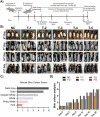Stimulation of hair regrowth in an animal model of androgenic alopecia using 2-deoxy-D-ribose
- PMID: 38887556
- PMCID: PMC11180715
- DOI: 10.3389/fphar.2024.1370833
Stimulation of hair regrowth in an animal model of androgenic alopecia using 2-deoxy-D-ribose
Erratum in
-
Corrigendum: Stimulation of hair regrowth in an animal model of androgenic alopecia using 2-deoxy-D-ribose.Front Pharmacol. 2024 Oct 25;15:1499205. doi: 10.3389/fphar.2024.1499205. eCollection 2024. Front Pharmacol. 2024. PMID: 39525630 Free PMC article.
Abstract
Androgenic alopecia (AGA) affects both men and women worldwide. New blood vessel formation can restore blood supply and stimulate the hair regrowth cycle. Recently, our group reported that 2-deoxy-D-ribose (2dDR) is 80%-90% as effective as VEGF in the stimulation of neovascularization in in vitro models and in a chick bioassay. In this study, we aimed to assess the effect of 2dDR on hair growth. We prepared an alginate gel containing 2dDR, polypropylene glycol, and phenoxyethanol. AGA was developed in C57BL6 mice by intraperitoneally injecting testosterone (TE). A dihydrotestosterone (DHT)-treated group was used as a negative control, a minoxidil group was used as a positive control, and we included groups treated with 2dDR gel and a combination of 2dDR and minoxidil. Each treatment was applied for 20 days. Both groups treated with 2dDR gel and minoxidil stimulated the morphogenesis of hair follicles. H&E-stained skin sections of C57BL/6 mice demonstrated an increase in length, diameter, hair follicle density, anagen/telogen ratio, diameter of hair follicles, area of the hair bulb covered in melanin, and an increase in the number of blood vessels. Masson's trichrome staining showed an increase in the area of the hair bulb covered in melanin. The effects of the FDA-approved drug (minoxidil) on hair growth were similar to those of 2dDR (80%-90%). No significant benefit were observed by applying a combination of minoxidil with 2dDR. We conclude that 2dDR gel has potential for the treatment of androgenic alopecia and possibly other alopecia conditions where stimulation of hair regrowth is desirable, such as after chemotherapy. The mechanism of activity of 2dDR remains to be established.
Keywords: 2-deoxy-D-ribose; C57BL6 mice; androgenic alopecia; chemotherapy; hair regrowth; minoxidil; testosterone.
Copyright © 2024 Anjum, Zulfiqar, Chaudhary, Rehman, Bullock, Yar and MacNeil.
Conflict of interest statement
The authors declare that the research was conducted in the absence of any commercial or financial relationships that could be construed as a potential conflict of interest.
Figures






References
-
- Anisa A., Dikici S., Waris T. S., Bashir M. M., Akhter S., Chaudhry A. A., et al. (2020). Developing affordable and accessible pro‐angiogenic wound dressings; incorporation of 2 deoxy D‐ribose (2dDR) into cotton fibres and wax‐coated cotton fibres. J. Tis. Eng. Regen. Med. 14 (No. 7), 973–988. 10.1002/term.3072 - DOI - PubMed
LinkOut - more resources
Full Text Sources
Miscellaneous

